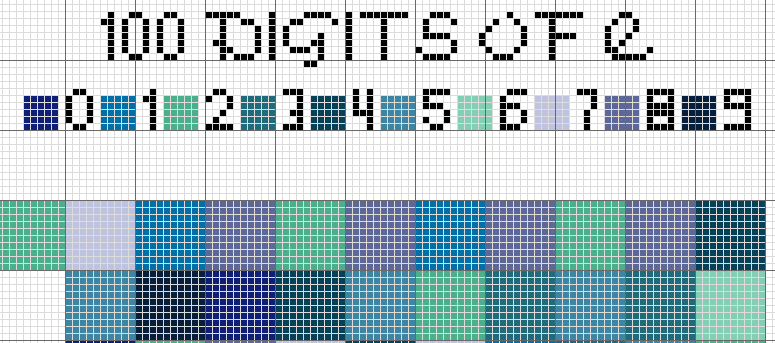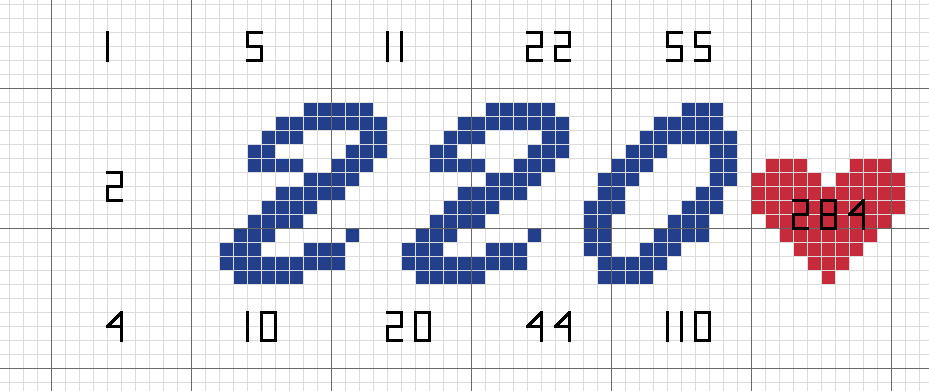Table of Contents
- Introduction to Science Communication for Mathematics
- Expressing the Creativity of Mathematics
- Cross Stitch Tutorial
- 15 Mathematical Cross Stitch Patterns
- Summary
One of the ways that I self-care is to design mathematical cross stitch patterns. The circumstances we are currently in require that we stay at home and social distance. It is a stressful and uncertain time all around the world. I have an anxiety disorder and depression and staying indoors it is easy to ruminate and have panic attacks. Yet, when I am cross stitching that disappears. It requires so much concentration to follow a pattern and count stitches. It doesn’t leave me a lot of time to worry. The other way that I am practicing self-care is by staying in touch with friends over video chat. We have been keeping up our regular game nights.
Introduction to Science Communication for Mathematics
Update: I wanted to add a disclaimer. This is how I’ve educated in the past and I know that isn’t helpful right now.
I still think these bookmarks are relevant for two reasons.
1. You can use them to talk about maths with your family or people you video chat with.
2. Of course, you can use them as personal items.
Just want to be clear that I support social distancing.
So, why mathematical cross stitch? It is a creative expression of my love of maths! It is also how I practice mathematical advocacy. I believe the best approach is to appeal to human curiosity. It is something we are all born with innately. By carrying around items that relate to mathematics, I am leaving an opening for people to question me. If you see a strange symbol, let’s say the notation for dek and el, you might wonder what they represent when they are shown in context.

That sort of inquiry is internally motivated and I think that is important when we have conversations about maths. I think the ultimate goal is to make mathematics personally meaningful to them. Even if it is through liking you as a person.
I don’t know if my approach is right. And it isn’t based on science or the best research. It is the way that I approach advocacy work and this approach has worked for me. Heck, I have a winning streak going on. The last two times that I’ve talked to strangers about maths they have thanked me for the conversation. I think that I’m getting better at reaching people.
Bookmarks are great items for advocacy work because they are so portable. They are useful everyday items that you keep around the house. You also take them when you go on vacation or travel on public transit. You can leave your bookmark out in the open while you read and wait for people to start a conversation.
Expressing the Creativity of Mathematics

What makes making these bookmarks meaningful to me is that they express the creativity of mathematics. These patterns show maths in a visually appealing way. It takes it from an abstract concept to something you can hold in your hands. I think it reveals the beauty of mathematics.
“Beauty is the first test: there is no permanent place in the world for ugly mathematics.”
- G.H Hardy
I think that is the hardest thing for a layperson to see, the beauty of it all. Yet, if you are a pure mathematics person like me then you can hardly see why somebody wouldn’t. And that is the divide we have to cross in science communication. Two versions of the same thing. One that causes pain and one that causes pleasure.
Cross Stitch Tutorial
I am going to assume that you are new to cross stitch. Looking at these patterns could be daunting. Do not fret! I will walk you through this with some tutorials that I’ve found online.
First, you should be aware that there are two types of cross stitch patterns.
1. Stamped Cross Stitch - This is when the design is stamped onto the fabric. This requires no counting. It is the easiest for beginners.
2. Counted Cross Stitch - The pattern is not stamped on the fabric. You must use a chart and count the stitches yourself. You start with a blank canvas, find the middle of the fabric, then start stitching with the middle stitches on the chart.
All the patterns below are counted cross stitch. On the diagram, there is an arrow on the top that signifies the middle column. There is an arrow on the side that marks the middle row. Find where that row and column intersect. That is the middle of the chart and those should be your first stitches in the middle of your fabric.
Finding the Starting Place to Stitch
You can easily find the middle of your fabric by folding it in half. Then fold it in half again. Where the folds meet is where the middle of your fabric is.
All these patterns are meant to be 8.5 x 2.5 inches long except where noted. This is one of the standard sizes for bookmarks. I know that is pretty long but you kind of need all that space to do a nice design where it is easy to see all the details. You will want to get yourself some 14-count Aida in black or white and cut it to size. There is only one design below that requires black Aida and that is the Enigma bookmark. All others are shown on white Aida.
There are two special stitches that you will need to know.
The Backstitch
The French Knot
That’s it for stitching!
You’ll also want to know how to finish your project.
Optionally, you can make a tassel for your bookmark.
You can create a bookmark by gluing your Aida to some felt cut to a matching size. I use this glue, Aleene’s Clear Gel Tacky Glue.
You’re done! On to the patterns.
15 Mathematical Cross Stitch Patterns
Links to download files open in the current tab.
1. 100 Digits of e
You may have seen these types of patterns before. It is a simple data visualization where you assign a color to each digit from 0-9. The point of doing a visualization like this is to show you that there is no discernible pattern. It also looks like modern art. I’ve made the colors into squares so that it looks a lot like a cross stitch sampler. Just to let you know, this project will take more time than a bookmark. In the end, it fits into an 11x14 frame.
Download 100 Digits of e Pattern

2. 100 Digits of pi(π)
I couldn’t leave out one of the most popular constants and transcendental number pi(π). It is the same data visualization technique as the 100 digits of e. These are meant to be companion pieces that you can hang up next to each other in your home. This pattern when completed will also fit into an 11x14 frame.
Download 100 Digits of pi Pattern

3. Enigma (Alan Turing)
This is the first pattern that I designed to celebrate the life of Alan Turing. I don’t want to go into all the details. He is one of my favorite mathematicians and I wanted to honor his work. This should be stitched on 14-count black Aida. Since the program I used to print this pattern only uses a white background. I have the letters stitched in black but for this pattern when you see black replace it with white instead when stitching.

4. Porgy (Alan Turing)
This is the second pattern that I made honoring Alan Turing. While I was in London, I went to Bletchley Park. There I saw Alan Turing’s teddy bear, Porgy. He had the bear as an adult and would use Porgy to practice his lectures! It made me feel connected to Turing.

5. Porgy
I also wanted to make Porgy by himself. This is the perfect size to frame using a 3-inch embroidery hoop. You can also turn it into a magnet.

6. Amicable Numbers - 220
This is a bookmark to share with a loved one. It is a companion to the 284 bookmark. These are the smallest pair of amicable numbers. This means that all the factors of 220 add up to 284. All the factors of 284 add up to 220.
Download Amicable Numbers 220 Pattern

7. Amicable Numbers - 284
This is a bookmark to share with a loved one. It is a companion to the 220 bookmark. These are the smallest pair of amicable numbers. This means that all the factors of 220 add up to 284. All the factors of 284 add up to 220.
Download Amicable Numbers 284 Pattern

8. Dozenal or Base 12
This bookmark features Dozenal! Also called Duodecimal and Base 12. My favorite video of all time of Numberphile is the one posted on 12-12-12.
Download Dozenal Bookmark with Dek, El, and Do digits

9. e
My favorite constant is e. This has to do with the fact that the derivative of e^x is e^x. It is a function that knows itself! I am all about self-knowledge. I made this bookmark to celebrate my love of e.

10. pi(π)
I felt that I couldn’t do digits of e bookmark without also doing one for pi(π). I released this pattern on pi(π) day of 2020. I’m republishing it for this list.
Download Digits of pi Bookmark

11. Curiouser and Curiouser
Hopefully, you recognize this quote. It is one of my favorites in all of literature and comes from Alice in Wonderland. It was written by Lewis Carroll, his pen name, who was a mathematician at Oxford called Charles Lutwidge Dodgson.
Download Alice in Wonderland Quote Pattern

12. 999 Happy Haunts
My favorite ride at Disneyland is the Haunted Mansion. This is the bookmark that celebrates that love of numbers and the love of that ride.
Download Haunted Mansion Pattern

13. Math Goddess
This is something my math professor said to me that helped me feel more confident. She said to think of myself as a math goddess. So, I made this bookmark to remind myself.

14. My Brain is Open
That same math professor, her favorite mathematician is Paul Erdős. I made this bookmark for her using an Erdős quote.
Download Paul Erdos Quote Pattern

15. Golden Ratio
This goes along with the previous patterns for e and pi.

Zork (Bonus)
I am sure if you like maths then you probably also like computer science. I thought that I would include this old school Zork quote for those who remember the game. This is also one of my favorite quotes.

Summary
I have found cross stitch to be one of my most engrossing hobbies. W hen I stitch time seems to stand still. It requires focus, concentration, and attention to detail. I love that I’m able to express my love of mathematics so creatively by designing new patterns. I hope you have downloaded some of them today.

